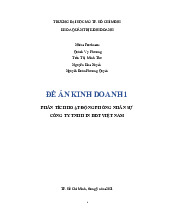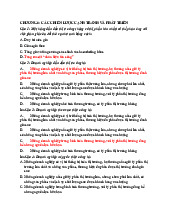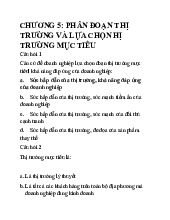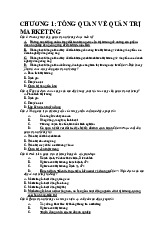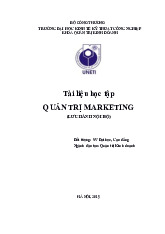



















Preview text:
Marketing Analyisis of Starbucks Content 1.
Introduction……………………………………………………………………………………Page 4
2. Situational Analysis……………………………………………………………………………Page 5-11
2.1. Market Overview……………………………….……………………….………………….Page 5
2.2. Lifecycle Stage………….…………………………….………………………………………Page 5
2.3. SWOT Analysis…………………………………………………………………………….….Page 6-7
2.4. Market Environment Analysis…………………………………….…………………..Page 8-11
2.4.1. Porter’s Five Force Analysis………..………………………………………………..Page 8-9
2.4.2. PESTLE Analysis……………………………………………………………………………Page 10-11
3.1. Segmentation………………………………………………………………………………….Page 11
3.2. Target Market Profile……...……………………………………………………….……..Page 12
3.3. Positioning……………………………………………………………………………………….Page 13
4.1. Marketing Objectives ………………………………………………………………………Page 14
4.2. Marketing Strategies………………………………………………………………………..Page 14-15
4.2.1. BCG Matrix…………………………………………………………………………………….Page 14
4.2.2. Ansoff Matrix…………………………………………………………………………………Page 14
4.2.3. Strategic Alliances………………………………………………………………………….Page 15
4.2.4. Porter’s Generic Strategy……………………………………………………………….Page 15
5. Implementation of Strategy………………………………………………………………...Page 16-19
5.1. Marketing Mix………………………………………………………………………………….Page 16-18
5.2. Branding ………………………………………………………………………………………….Page 19
6. Suggestion & Control….……………………………………………………………………….Page 20
7. Conclusion…………………………………………………………………………………………..Page 21
8. Reference…………………………………………………………………………………………….Page 22-25 1 | P a g e 1. Introduction:
Starbucks is one of the biggest company in the specialty coffee market in the world,
operating in 62 countries. It has been proven to be very successful in retail coffee market
due to its well-planned marketing strategy (Forbes.com, 2013). In order to achieve success,
Starbucks has utilised a strong strategic marketing plan.
Even though the very first objective of Starbucks is to make profits, the mere purpose of
Starbucks should be creating customers rather than focusing on making profits (Winer, 2007,
p6). Levitt (1986) also emphasized on keeping and creating customers. Customer based
strategy is also referred as marketing concept (Hooley et al, 2012, p29). Marketing is a
process of identifying, anticipating and satisfying customers’ requirements (Cim.co.uk, 2015).
Starbucks is also determined to establish themselves as a lovable brand among consumers
(Starbucks.com, 2015). Marketing plan of Starbucks is devised based on establishing customer satisfaction.
Pride & Ferrell (2014) demonstrate marketing as more than advertising and selling; it is a
strategy of development and management of product that will satisfy needs of customers
(p5). Customers buy products for benefits that fulfil their needs (Winer, 2007, p12). A strong
strategic plan should include a set of strategies which will create desire for Starbucks
products among customers. Strategic marketing plan is not only focused on satisfying
customer’s needs. It should be able help identifying customers as well (Cim.co.uk, 2015).
By developing a strong strategic marketing plan, Starbucks will be able to improve profits and
sales performance (Cadogan, 2012). It will also allow Starbucks to understand about
competitors in the market using situational analysis and develop strategies to achieve
competitive advantage. According to Kotler et al (2012), a successful marketing plan allows
companies to understand, create and sustain customer-perceived value (p95). It also allows
companies to stand out in the market. 2 | P a g e
2. Situational analysis: 2.1. Market Overview:
Starbucks mainly operates in the retail coffee industry. According to Pitek (2009), ‘Starbucks
main competitors are quick-service restaurants and specialty coffee shops’. Coffee shops and
restaurants such as Dunkin’ Donuts, McDonald’s, Costa and Subway have homogeneous
items with similar tastes and effect as the Starbucks. According to Geereddy (2015),
Starbucks is the market leader in this industry with a market share of 36.7%. By being the
market leader in retail coffee industry, Starbucks has been able to dominate in setting up
trends that lets it to grow into bigger organisation. There is also an increase in the overall
coffee consumption market (Keynote.co.uk, 2015). 2.2 Lifecycle Stage:
In fiscal 2013, Starbucks generated a record $14.9 billion revenues. The business of
Starbucks is increasing in a steady rate. For last 4 years Starbucks growth rate is stuck in 7%
to 8%. If you look at this data, Starbucks is still in the growth stage in product life cycle (Polli & Cook, 1969).
Figure 1: Starbucks annual revenues and growth rate (Starbucks.com, 2015) 3 | P a g e 2.3 SWOT Analysis:
Starbucks SWOT has conducted by mainly analysing data from Starbucks.com (2015) and Keynote .co.uk (2015). Strength:
Strong market position: Starbucks is the market leader in the retail
coffee industry. Sales are increasing every year in a steady rate.
Global brand recognition: Starbucks is operating in 62 countries around
the world. Because of its wide geographical presence, Starbucks has
been voted 91st in the best global brands list 2013 (Geereddy, 2015).
Enormous number of branches: Starbucks has huge number of branches
in the world. Density of branches are also very high. According to
Burkeman (2007), there are around 164 Starbucks branches in a 5 miles
radius in London. Most of the branches are placed in prime location.
Diversified product list: Starbucks product portfolio is very extensive
ranging from coffee, tea, ready-made meals and etc. Loyal customers.
Technology and environmental friendly attitude: Starbucks has
developed a mobile applications and cards for rewards for its users. It is
also famous for its community works for both suppliers and customers. Weakness:
Negative image issue: It has recently been scrutinised for skipping tax in the UK (Smale,2015).
Overcrowded product portfolio: Starbucks has a very large and complex
number of products. It spends a lot of resources in developing new products every year.
Premium priced products.
Dependence on coffee industry.
Complex global management. 4 | P a g e Opportunities:
Coffee industry is expanding globally.
Scope of emerging markets: New emerging countries such as India and
Brazil could become a market (Lynn et al, 2011).
Expansion of product offerings in online and supermarkets.
Brand extension: Starbucks brand portfolio could be expanded in other
markets because it’s a widely known brand.
Use of vending machines: By setting up more vending coffee pouring
machines, Starbucks can reduce costs and enhance their brand representation.
It can become a more socially responsible brand and establish strong emotional connections. Threats:
Huge pressure from increased competition: Coffee industry is a very
competitive industry. Fast food companies like McDonalds and Subway
have started exploring this market.
Fluctuation in US economy can cause damage in a great extent because
Starbucks is dependent on US sales.
Change in people’s lifestyle: People are becoming more aware about
sugar and calories they consume (Ruhs, 2012).
Warm weather: There is a huge increase in temperatures around the
world. If it becomes too hot, consumers are less likely to consume coffee. 5 | P a g e
2.4 Market Environment Analysis:
In order to survive in the competitive market, Starbucks must analyse its marketing
environment (Kotler et al, 2012; p174). Marketing environment is divided into two sections
such as micro environment and macro environment. Immediate surroundings of a company
is called micro environment. It consists of customers, competitors, suppliers and distributors.
Macro environmental factors can be analysed using Porter’s five forces model. On the other
hand, macro environment consists of external elements such as political, environmental,
social, technological, ecological and legal factors. These can be analysed using PESTLE analysis
2.4.1 Porter’s Five Force Analysis: o
It is a lucrative and expanding market. So a lot of
new companies are trying to invest and gain Threat of market share. New o
Localised shops can compete with Starbucks very easily. Entrants: o
In order to compete with Starbucks, new
companies will have to compete in global levels. High o
Set up costs of a coffee shop is relatively low, so
any company with space can enter into the retail coffee market. o
Starbucks collects raw materials for their coffee Bargaining
from so many different suppliers. Baines et al (2011)
says that 'in an industry where there is a large Power of
number of suppliers, the buying company have the bargaining advantage'. Suppliers: o
It is totally independent on outsourcing coffee
beans. International political tensions can give Low to suppliers an upper-hand. o
Arabica coffee beans provide signature taste of Moderate
Starbucks coffee. It only grows in particular part of the world. 6 | P a g e o
Tea is the main substitutes of coffee. Caffeine Threat of
drinks, fruit juice, water and soda drinks are also prime substitutes. Substitutes: o Instant coffee products. High o Premium coffee makers at home. Bargaining o
Low volume of purchase do not allow buyers to think about the price. Power of o
Established price of coffee against value do not allow buyers to argue. Buyers: o
There are not much difference between substitute products and coffees Low o
Huge number of competitors in retail coffee industry. Intensity of o
Main competitors are major organisations such as
Costa, McDonald’s are also doing global business. Competitive o
McDonald’s coffee is relatively cheap (Kurtz, 2012). Rivalry: o
Starbucks coffee is differentiated by providing premium coffee. High o
Starbucks is the leading company in the coffee
industry which brings intensive rivalry from every competitors. 7 | P a g e 2.4.2. PESTLE Analysis: 8 | P a g e
Relationship between USA and supplying countries can be vital. Political:
Local political tensions of supplying countries
can jeopardise the collection process.
Starbucks are recently being scrutinised for not
using ‘Fair-trade’ policy.
High inflation rates decrease the level of buying power. Economical:
Fall in local currency rates compared to dollars.
Taxes has been increased.
People’s awareness about calories and
embracement of healthy life style. Social:
Literacy rate is increasing everyday which
increases people’s curiosity in coffee.
Globalisation has brought people to try
different cultures and more people are drinking coffee as an experience.
Wi-Fi is a must for any coffee shops. Technological:
Mobile payment and rewards using mobile phone application.
People’s interest in using internet for shopping.
Improvements in agriculture is improving
productions of coffee beans.
Introduction of new laws on consumption of
caffeine related drinks. 9 | P a g e Legal:
Laws in operating countries can differentiate.
Increase in National minimum wages of staffs.
Recycling has become a big issue. Ecological:
Natural disasters in coffee beans producing
countries and buyers countries. Global warming. 3.1. Segmentation:
According to Weinstein (2004), segmentation is an integral part of developing a successful
marketing strategy. It is referred as the process of segmenting market into distinct group
with homogeneous interests (Bose, 2012, p114). It is essential to divide market into
segments because ‘understanding how buyers needs and wants vary is essential in designing
effective marketing strategies’ (Cravens & Piercy, 2013).
3.1.1. Segmentation Methods:
Starbucks has used socio-economic and demographic methods to segment their market.
(Dominous, 2006; O’Farrell, 2015). It has segmented its market based on age, gender,
income, education, occupation and social class of people.
3.2. Target Market Profile:
After deciding methods of segmentation, Starbucks should have decided to approach how
many and which segments to approach (Wilson & Gilligan, 1998, p297). This process is called
targeting (Cravens & Piercy, 2013). Starbucks target market profile can be divided into two
markets such as primary and secondary.
3.2.1. Primary Target Market:
Age: 24 to 40 years old.
Gender: Both male and female. Income Group: ABC1. 10 | P a g e
Education: Graduates.
Occupation: Higher managerial, intermediate managerial, supervisory or clerical and junior managerial.
Social Class: Upper middle, middle and lower middle class.
3.2.2. Secondary Target Market:
Age: 18 to 23 years old.
Gender: Both male and female.
Education: Under-graduates.
Occupation: Students.
Social Class: Upper middle, middle and lower middle class. 3.3. Positioning:
Positioning is described as the marketing programmes that are developed based on the
appropriateness of targeted segments (Venter et al, 2015). According Kotler et al (2012,
p396), the goal of positioning is to ‘establish the brand in the mind of consumers in order to
maximise the potential benefits to the firm’.
3.3.1. Perceptual or Positioning Mapping:
Positioning is a concept which 'indicates management's desired positioning of the product
(brand) in the eyes and mind of targeted buyers' (Cravens & Piercy, 2013, p173). It allows
companies to deliver value requirements according to target markets. Starbucks positions
itself as a premier or high price coffee company who wants to sell high quality products to
mostly young people with good income or have potential to earn money. Starbucks wants to be perceived as a brand in th 'high quality'
e mind of consumers. Starbucks main competitors
such as Dunkin Donuts, Costa who have positioned themselves similar to Starbucks. On the
other hand, McDonalds and Subway has positioned themselves as low priced and high quality product providers. 11 | P a g e
Figure 2: Positioning map of retail coffee market (Kotler et al, 2012, p405)
4.1. Marketing Objectives and Goals:
Establishing Starbucks as a premium coffee providing brand globally by focusing on
development of high quality products.
To establish Starbucks as a ‘third place’ for consumers where they can enjoy coffee
with ambient music, internet and etc.
To improve brand image through excellent customer service.
Increase sales by forming alliances with supermarkets and enhancing product offerings. 12 | P a g e
4.2. Marketing Strategies: 4.2.1. BCG Matrix:
BCG Matrix permits companies to maintain its portfolio by acknowledging the relative
market share position and industry market growth (Armstrong & Kotler, 2003). The BCG
Matrix identifies 4 cells such as Question Marks, Stars, Cash Cows and Dogs (Wilson &
Gilligan, 1998, p312). 'Stars represent units with high market shares in high-growth market' (Kurtz, 2012).
According to Starbucks.com (2015), business of Starbucks has been increasing in a high rate.
So it can be determined that it has a high position in sales growth rate. Coffee industry is
also increasing in a high rate every year (Keynote.co.uk, 2014). As Starbucks is in Star
position, it will need to invest heavily (Wilson & Gilligan, 1998). 4.2.2. Ansoff Matrix:
The Ansoff matrix is also called ‘product-market matrix’ (Dibb et al, 2012). Because the
marketing strategy is developed by analysing products and market. Starbucks belongs to
existing market with existing product. So this matrix advises a strategy called 'market
penetration' for Starbucks. This strategy will enable Starbucks to increase sales in present
market with existing products (Dibb et al, 2012). To do that, Starbucks will have to penetrate
market via aggressive advertising and promotions.
4.2.3. Strategic Alliances:
Companies cannot achieve leadership in the market without forming alliances with domestic
and multi-national companies (Kotler et al, 2012, p117). By forming alliances with
companies, Starbucks has been able to gain shelf space in supermarkets such as ASDA, Tesco
and etc. This kind of alliance are called ‘product alliance’. I will allow Starbucks to produce
new market offering (Kotler et al, 2012).
4.2.4. Porters Generic Strategy:
Porter has identified three generic types of strategy such as cost leadership, differentiation
and focus (Wilson and Gilligan, 1998, p326). According Porter’s theory, Starbucks must use
differential techniques because they are the market leader. Starbucks is always focused on
establishing themselves as high quality coffee brand (Starbucks.com, 2015). It has chosen
‘differentiation’ technique to gain competitive advantage. According to Kotler et al (2012,
p408), when any company chooses such strategy, they will meet prospective of buyers by
providing high quality products. It will lead to enjoyable purchase experience. Kotler et al
(2012) also says that it allows companies to charge higher price. 13 | P a g e
5. Implementation of Strategies: 5.1. Marketing Mix: Product:
Starbucks has a wide product list to fulfil the needs of its buyers.
Coffee related drinks are the main products of Starbucks. Starbucks is keeping its
core in coffee industry due to the growth of coffee industry.
It is selling not only hot drinks but also cold drinks to be able to make money in
summer and warm weather condition.
By adding sandwiches, Panini, biscuits, pastries and etc. to its product line, Starbucks has been able to bulk sales.
Salads are being sold for healthy lifestyle lovers.
Syrups are being added instead of sugars to encourage people to believe Starbucks
products as low calorie products.
In order to compete with instant coffee products, Starbucks has developed their own instant coffee products range.
Starbucks has made alliances with different supermarkets to produce products for
them. For example, Starbucks's cold coffees are sold in supermarkets. Price:
Price is kept high to keep itself as a 'high quality' brand in consumers mind.
But price is not higher than main competitors to keep switching cost to low level.
Different sizes are used to accommodate customers’ needs. Tall, Grande and small
are priced differently to meet customers’ budgets. Place:
Starbucks is expanding its business globally to increase sales, covering 62 countries.
There are over 21,000 stores of Starbucks around the world. In 2013, Starbucks has
established 1599 new stores (Statista.com, 2015).
It formed alliances with other local shops to integrate with them by setting up
machines. For eg. Starbucks alliances with University of Chester. 14 | P a g e
It has positioned its stores in 'high-traffic' areas to attract consumers.
Stores are placed in clusters to achieve maximum brand awareness (Burkeman, 2007). Promotion:
It's more focused on building relationships with consumers rather than heavy
advertising. It is merely dependent on 'word of mouth'.
Starbucks takes CSR very strongly. They have developed numerous number of
community projects to establish themselves as a socially responsible brand.
Starbucks cards are introduced to retain loyal customers.
Starbucks uses 'social-media' as platforms to promote its new products because it
has huge popularity there (Boychenko, 2012). People:
It has positioned itself as a 'friendly' brand by providing high quality customer service.
Staffs are given training to provide quality service.
A lot of welfare programmes are utilised to improve and encourage workforce. Process:
Starbucks's staffs write consumers name on products which builds a stronger relationship with consumers.
There is a little waiting time but consumers are always kept informed.
System is developed for convenience of consumers.
'My Starbucks Idea' has been introduced to get customer feedbacks and supports. 15 | P a g e Physical Evidence:
Starbucks has used colour green in their identity to promote itself as environmental friendly.
It uses modern architectural design to present its stores.
It provides all kinds of information about its products and business through Starbucks.com.
Most of its products are sold through stores.
Starbucks designs it stores in a way to make people enjoy coffee. For example, it uses to ambience music in stores.
5.2. Branding Strategy:
Starbucks has kept speciality coffee as its core product for a long time (Seaford et al, 2012). Seaford
(2012) also says that, by keeping its core to speciality coffee market, Starbucks is branded as coffee
brand in the consumers mind. Starbucks is mainly focused on providing high quality product with
excellent customer service. Main brand values of Starbucks are ‘friendly’, ‘relaxing’, ‘trendy’ and
‘innovative’. Branding is kept identical in all of the products and stores by using same logo.
Figure 3: Starbucks Brand Values and Essence 16 | P a g e
6. Suggestion & Control:
Even though business of Starbucks is growing, there are some steps can be taken to improve
effectiveness of marketing plan. Below they are explained;
Starbucks is investing very little amount of money in advertising and promotions. It
will have to allocate more budget in advertising to gain competitive advantage (Crain, 2011).
By extending its product range to fruit drinks, Starbucks can achieve higher sales rates (Gerreddy, 2015).
It can use focused differentiation technique to approach the market rather than using
differentiation technique (Shaw, 2012). Latif et al (2014) also says that, Starbucks
could gain more success if they provide economical products.
50% of income of Starbucks comes from the sales in U.S.A., it needs to focus on
emerging markets. ‘China, India and Brazil are expected to be among the world's
largest economies by the year 2050’ (Lynn et al, 2011). If Starbucks do not focus
more on emerging markets, it will have to lose business.
By providing healthy alternatives of their products, Starbucks will be able to react to
current trends. According to Ruhs (2012) ‘heart-healthy or gluten-free products can significantly impact sales’.
It is very essential to become a socially responsible brand by using CSR techniques.
Because it will allow Starbucks to achieve competitive advantage (Wang & Anderson,
2011). More involvement with communities especially at University and college could create a strong effect.
Forming alliances with smaller shops to provide Starbucks branded coffee and other
products could leads to high increase in sales (Kotler et al, 2012).
Targeting new segments such as teens could be crucial in developing a better
strategy for future (Latif et al, 2014).
Starbucks is already famous for providing free ‘Wi-Fi’ at stores as added benefits in
stores (Fitzgerald, 2013). It can add new services such as ‘Library’ and ‘entertainment
stores’ using their mobile app to add benefits for their customers. 7. Conclusion:
Smale (2015) has argued that sales of Starbucks are going to go down because of low level of
differentiation with competitors. To sustain its situation, Starbucks will need to plan ahead. It
will need to plan marketing activity by analysing environments (Pettitt & Brassington, 2003).
In terms of planning, Starbucks must keep in mind to be customer-focused to create value
for its target market (Cravens & Piercy, 2013). It is also necessary to make control if it’s
needed to meet trends and environments (Hooley et al 2012). If they can apply strategies
effectively, they will become a very successful company (Kotler et al, 2012). 17 | P a g e 8. References:
Armstrong, G. & Kotler, P. (2003). Marketing an Introduction. (2nd ed). New Jersey: Pearson Education Ltd.
Baines, P., Fill, C. & Page, K. (2011). Marketing. (2nd ed). New York: Oxford University Press.
Smale, W. (2015) Why Starbucks' sales have gone cold. BBC. Retrieved from.
http://news.bbc.co.uk/1/hi/business/7219458.stm
Bose, T. (2012). Market Segmentation and Customer Focus Strategies and Their Contribution
towards Effective Value Chain Management. International Journal of Marketing Studies. 4(3). 113-121.
Boychenko, M. (2012). It's Not Just Coffee, It's Starbucks. Retrieved from
http://thecoffeeteam.blogspot.co.uk/2012/02/3-more-ps.html
Burkeman, O. (2007). A serious case of caffeine overdose. The Guardian. Retrieved from
http://www.theguardian.com/business/2007/jan/16/globalisation.retail
Cadogan, J. W. (2012). International marketing, strategic orientations and business success.
International Marketing Review, 29(4), 340-348.
doi:http://dx.doi.org/10.1108/02651331211242656
Cim.co.uk. (2015). An Overview of Marketing. Retrieved from
http://www.cim.co.uk/marketingplanningtool/intro.asp
Crain, R. (2011). Herb kelleher on the importance of advertising to southwest's success.
Advertising Age, 82(18), 95. Retrieved from
http://search.proquest.com/docview/864878261?accountid=14620
Cravens, D., & Piercy, N. (2013). Strategic Marketing (10th ed.). Singapore: McGraw-Hill.
Dibb, S., Simkin, L., Pride, W. & Ferrell, O. (2012). Marketing Concepts & Strategies. (6th ed).
Hampshire: Cenage Learning EMEA.
Dominous, S. (2006). The Starbucks Aesthetic. The New York Times. Retrieved from
http://www.nytimes.com/2006/10/22/arts/22domi.html?
em&ex=1161748800&en=74b4f3e958fdeb7d&ei=5087%0A&_r=1&
Fitzgerald, M. (2013). How Starbucks has gone digital. MIT Sloan Management Review,
54(4), 1-8. Retrieved from http://search.proquest.com/docview/1399095649? accountid=14620
Forbes.com (2013). Starbucks And McDonald's Winning Strategy. Forbes. Available at:
http://www.forbes.com/sites/panosmourdoukoutas/2013/04/25/starbucks-and- mcdonalds-winning-strategy/
Geereddy, N. (2015). Strategic Analysis Of Starbucks Corporation. Harvard. Retrieved from
http://scholar.harvard.edu/files/nithingeereddy/files/starbucks_case_analysis.pdf 18 | P a g e
Gupta, M., Sahi, G., & Chahal, H. (2013). Improving market orientation: the theory of
constraints-based framework. Journal of Strategic Marketing, 21(4), 305-322.
doi:10.1080/0965254x.2013.790467
Hooley, G., Piercy, N., & Nicoulaud, B. (2012). Marketing Strategy and Competitive
Positioning (5th ed.). Essex: Pearson Education.
Keynote.co.uk. (2015). Coffee & Sandwich Shops - 2014 – Full report. Retrieved from
http://www.keynote.co.uk/market-intelligence/view/product/11004/coffee-%26-
sandwich-shops?highlight=starbucks&utm_source=kn.reports.search#
Kotler, P., Keller, K., Brady, M., Goodman, M., & Hansen, T. (2012). Marketing Management
(2nd ed.). Essex: Pearson Education Ltd.
Kurtz, D. (2012). Principle of Contemporary Marketing.(15th ed). USA: Cengage Learning.
Latif, M., Qurat-ul-ain, H., Gulzar, H., Bukhari, S. R., & Sameen, S. N. (2014). Starbucks
sustained during economic crisis. International Journal of Accounting and Financial
Reporting, 4(1), 307-321. doi:http://dx.doi.org/10.5296/ijafr.v4i1.6084
Levitt, T. (1986). The Marketing Imagination. New York: Free Press.
Lynn, David J, C.R.E., Wang, T., & Mehlum, C. (2011). Investing in emerging markets: China,
india and brazil. Real Estate Issues, 36(2), 21-26. Retrieved from
http://search.proquest.com/docview/940913095?accountid=14620
O'Farreell, R. (2015). Who Is Starbucks' Target Audience? Demand Media. Retrieved from
http://smallbusiness.chron.com/starbucks-target-audience-10553.html
Pettitt, S. & Brassington, F. (2003) Principles of Marketing. (3rd ed.). Harlow: Pearson Education Ltd.
Pitek, M. (2009). Starbucks Coffee. Rensselaer Hartford. Retrieved from
www.ewp.rpi.edu/hartford/~stoddj/BE/starbucks%20final.doc
Polli, R., & Cook, V. (1969). Validity of the Product Life Cycle. The Journal of Business, 42(4), 385. doi:10.1086/295215
Pride, W., Pride, W., & Ferrell, O. (2007). Foundations of marketing. Boston: Houghton Mifflin Co.
Ruhs, B. (2012). Healthy Competition. Progressive Grocer, 91(11), 24.
Seaford, B. C., Culp, R. C., & Brooks, B. W. (2012). Starbucks: Maintaining a clear position.
Journal of the International Academy for Case Studies, 18(4), 39-57.
Shaw, E. H. (2012). Marketing strategy. Journal of Historical Research in Marketing, 4(1), 30-
55. doi:10.1108/17557501211195055
Starbucks Coffee Company,. (2015). . Re Responsibility trieved 12 January 2015, from
http://www.starbucks.com/responsibility
Starbucks Coffee Company,. (2015). . R Starbucks Card
etrieved 12 January 2015, from https://www.starbucks.com/card 19 | P a g e
Starbucks Coffee Company,. (2015). Starbucks Coffee Company. Retrieved 12 January 2015, from http://www.starbucks.com/
Starbucks.com,. (2015). Annual Reports | Investor Relations | Starbucks Coffee Company.
Retrieved 12 January 2015, from http://investor.starbucks.com/phoenix.zhtml?
c=99518&p=irol-reportsAnnual
Starbucks.com,. (2015). Stores. Retrieved 12 January 2015, from
http://store.starbucks.com/on/demandware.store/Sites-Starbucks-
Site/default/Default-Start?cm_mmc=Sbuxcom-_-ShopMega-_-ShopTab-_-Evergreen
Statista.com,. (2015). Number of Starbucks stores worldwide from 2003 to 2014. Retrieved
12 January 2015, from http://www.statista.com/statistics/266465/number-of- starbucks-stores-worldwide/
Venter, P., Wright, A., & Dibb, S. (2014). Performing market segmentation: a performative
perspective. Journal of Marketing Management, 31(1-2), 62-83.
doi:10.1080/0267257x.2014.980437
Wang, A., & Anderson, R. B. (2011). A multi-staged model of consumer responses to CSR
communications. The Journal of Corporate Citizenship, (41), 51-68. Retrieved from
http://search.proquest.com/docview/1446439364?accountid=14620
Wilson, R., & Gilligan, C. (1998). Strategic marketing management (2nd ed.). Oxford: Butterworth-Heinemann.
Winer, R. S. (2007) Marketing management. Upper Saddle River, N.J: Pearson Prentice Hall. 20 | P a g e
